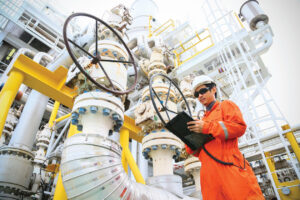Selecting a Personal Sampling Pump for the Offshore Oil & Gas Industry
By: Tim Turney, Contributor
Workers in the offshore oil and gas industry are exposed to a range of hazardous substances, leaving them vulnerable to asthmatic and allergic reactions, as well as longer term illnesses—such as cancer and cardiovascular, respiratory and nervous system disorders. While the cost to human health can be devastating, the financial costs to businesses through reduced productivity, employee absences, recruitment and compensation claims can be substantial.
OSHA issues citations and penalties if businesses violate permissible exposure limits (PEL). PELs are legal limits designed to control employee exposure to hazardous substances in an eight-hour period to prevent health risks. However, employers are also advised to monitor recommendations from industrial hygiene experts and manufacturers, because it is estimated that 90% of OSHA’s PELs have not been updated since the 1960s.[1] Consequently, OSHA may issue citations under the general duty clause of the Occupational Safety and Health Act (OSH Act) if exposure limits exceed industry-wide standards and pose a threat to employee health.
Industrial hygiene methods are geared towards measuring personal exposure using personal air sampling pumps, because the tried-and-tested method can quantify personal exposure and ensure compliance with regulatory limits. A sampling pump’s size, weight, connectivity and ability to access data are key; however, flow rate stability, pulsation and back-pressure capability must also be considered. So, when purchasing a sampling pump, what features should you look for?
Safety Ratings
Many pumps are Intrinsically Safe (IS) rated as standard, but it is worth checking that your pump’s IS rating is still appropriate for your facility to avoid any safety issues. An IS-rated pump will not cause an explosion in a flammable atmosphere, which is critical for workplaces with significant levels of combustible substances. In addition, consider whether the pumps will be used in a harsh environment. For example, many pumps now have Ingress Protection ratings, which means they are protected from ingress by water and dust.
Design
Size, weight and accessibility are critical design elements. Pumps should allow freedom of movement as well as be unobtrusive, robust and not prone to leakage. Selecting a smaller, lightweight, low-flow pump (0.05-1L) for sampling vapors and gases, over a medium flow pump (1-5L) equipped with a low flow adaptor is more user-friendly for workers.
 Battery Life
Battery Life
When selecting a personal sampling pump, the battery life must be considered to maintain operation throughout the monitoring period. Lithium-ion batteries are now starting to be used in the latest personal sampling pumps with significant advantages over traditional nickel-metal hydride and nickel-cadmium batteries. For example, li-ion batteries have the highest energy density, which means that you need fewer cells and can ultimately achieve a smaller, lighter pump. Li-ion batteries also do not suffer from the “memory effect,” meaning only part of the battery charge is usable. This will avoid having to change the batteries regularly or implement a battery management procedure.
Compliance
It is vital to check that your pump meets the latest international standard for air sampling pumps. Compliance with ISO 13137 ensures accurate flow performance amongst other performance criteria, ensuring accurate sampling—and meaning you will not have to repeat measurements.
Back-Pressure Capability
The most significant factor to consider in the operational capabilities of your personal sampling pump is the choice of media. For vapors or gases, the more back pressure the tube produces, or if multi tube sampling is required, ensure this back pressure can be handled by the pump. Will they cope?

Workers in the offshore oil and gas industry are exposed to a range of hazardous substances, leaving them vulnerable to asthmatic and allergic reactions, as well as longer term illnesses. (photo courtesy Adobe Stock Images)
Pulsation and Air Flow
If monitoring for dusts with a medium flow pump, the ISO 13137:2013 standard requires that the pulsation of a personal sampling pump shall not exceed 10% of the flow rate. A pulsation measurement shows the difference in air flow between cycles; through every cycle, as the pump draws air in and expels it simultaneously, this exchange process causes an uneven flow. A large pulsation value means that if you are using a cyclone head for collecting respirable samples, flow does not remain steady, and the size cut of the respirable fraction is affected. To combat this effect, manufacturers include pulsation dampeners, which are rubber diaphragms that act as extra reservoirs of air to smooth the flow. Ensure that the pulsation values are within specification for your chosen pump.
Most pumps control the flow of air through the pump using a “constant flow” mechanism. As back pressure increases, the pump detects the change and alters the flow accordingly. At the end of the sample, flow should still be within plus or minus 5% of the calibrated flow set at the start of the measurement. A constant flow ensures that you can be confident in the volume of air sampled for your exposure calculations.
Constant Pressure Control
“Constant pressure control” is primarily used for low-flow applications and allows the possibility of taking samples with sorbent tubes for gases and vapors. This method controls the flow rate by holding a constant pressure level in the tubing between the samplers and the pump. For many pumps, in order to do a low-flow measurement, you would purchase a separate constant-pressure controller. If you frequently undertake low-flow measurements, it is worth investing in a pump that has this built-in.
Connectivity and Bluetooth
The latest generation of Bluetooth®-enabled pumps and flow calibrators can automate the calibration process and save valuable time, increasing confidence in the calibration results, which can be saved and/or emailed for reporting. Pulsation, once tested in a laboratory, can now be checked in the field at the same time as a normal flow-rate calibration through an airflow calibrator equipped with Bluetooth. As advances in technology continue to develop, remote methods can avoid disturbing workers and improve the validity and reliability of sample data.
It is vital that these factors, alongside the broader environmental conditions in the specific working environment, are at front of mind when purchasing new equipment. Monitoring will help keep employees protected throughout the working day by ensuring air-sampling pumps identify hazardous amounts of fumes, dust and gases that increase the risk of long-term damage to worker health.
About the Author
Tim Turney is Global Marketing Manager at Casella and graduated as an Engineer from Queen Mary and Westfield in London. Since starting at Casella in 1998, Tim has been involved in the acoustics and air sampling industry, specializing in measurement and instrumentation technologies. Casella works with a network of specialist distributors to provide local service and client support to those searching out solutions for risk reduction and management. www.casellasolutions.com
[1] https://cen.acs.org/safety/industrial-safety/Former-OSHA-head-David-Michaels/99/i24
Share on Socials!
How to Implement an Effective Quality Management System
Advances in Respiratory Protection Program Management & Fit-Testing Systems
The Biggest Safety Hazard Threatening Lone Workers
Leaders in Industrial Hygiene
Council for Accreditation in Occupational Hearing Conservation (CAOHC)
Subscribe!
Sign up to receive our industry publications for FREE!










